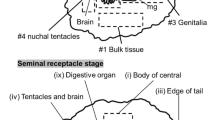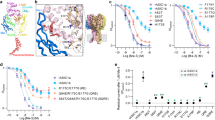Abstract
Acetylcholine receptors (AChRs) are pentameric ligand-gated ion channels involved in the neurotransmission of both vertebrates and invertebrates. A number of anthelmintic compounds like levamisole and pyrantel target the AChRs of nematodes producing spastic paralysis of the worms. The muscle AChRs of nematode parasites fall into three pharmacological classes that are preferentially activated by the cholinergic agonists levamisole (L-type), nicotine (N-type) and bephenium (B-type), respectively. Despite a number of studies of the B-type AChR in parasitic species, this receptor remains to be characterized at the molecular level. Recently, we have reconstituted and functionally characterized two distinct L-AChR subtypes of the gastro-intestinal parasitic nematode Haemonchus contortus in the Xenopus laevis oocyte expression system by providing the cRNAs encoding the receptor subunits and three ancillary proteins (Boulin et al. in Br J Pharmacol 164(5):1421–1432, 2011). In the present study, the effect of the bephenium drug on Hco-L-AChR1 and Hco-L-AChR2 subtypes was examined using the two-microelectrode voltage-clamp technique. We demonstrate that bephenium selectively activates the Hco-L-AChR1 subtype made of Hco-UNC-29.1, Hco-UNC-38, Hco-UNC-63, Hco-ACR-8 subunits that is more sensitive to levamisole than acetylcholine. Removing the Hco-ACR-8 subunit produced the Hco-L-AChR2 subtype that is more sensitive to pyrantel than acetylcholine and partially activated by levamisole, but which was bephenium-insensitive indicating that the bephenium-binding site involves Hco-ACR-8. Attempts were made to modify the subunit stoichiometry of the Hco-L-AChR1 subtype by injecting five fold more cRNA of individual subunits. Increased Hco-unc-29.1 cRNA produced no functional receptor. Increasing Hco-unc-63, Hco-unc-38 or Hco-acr-8 cRNAs did not affect the pharmacological characteristics of Hco-L-AChR1 but reduced the currents elicited by acetylcholine and the other agonists. Here, we provide the first description of the molecular composition and functional characteristics of any invertebrate bephenium-sensitive receptor.




Similar content being viewed by others
References
Aceves J, Erlij D, Martinez-Maranon R (1970) The mechanism of the paralysing action of tetramisole on Ascaris somatic muscle. Br J Pharmacol 38(3):602–607
Aubry ML, Cowell P, Davey MJ, Shevde S (1970) Aspects of the pharmacology of a new anthelmintic: pyrantel. Br J Pharmacol 38(2):332–344
Boulin T, Gielen M, Richmond JE, Williams DC, Paoletti P, Bessereau JL (2008) Eight genes are required for functional reconstitution of the Caenorhabditis elegans levamisole-sensitive acetylcholine receptor. Proc Natl Acad Sci USA 105(47):18590–18595
Boulin T, Fauvin A, Charvet CL, Cortet J, Cabaret J, Bessereau JL et al (2011) Functional reconstitution of Haemonchus contortus acetylcholine receptors in Xenopus oocytes provides mechanistic insights into levamisole resistance. Br J Pharmacol 164(5):1421–1432
Burrows RB (1958) The anthelmintic effect of bephenium on Ancylostoma caninum. J Parasitol 44(6):607–610
Colquhoun L, Holden-Dye L, Walker RJ (1991) The pharmacology of cholinoceptors on the somatic muscle cells of the parasitic nematode Ascaris suum. J Exp Biol 158:509–530
Copp FC, Standen OD, Scarnell J, Rawes DA, Burrows RB (1958) A new series of anthelmintics. Nature 181(4603):183
Culetto E, Baylis HA, Richmond JE, Jones AK, Fleming JT, Squire MD et al (2004) The Caenorhabditis elegans unc-63 gene encodes a levamisole-sensitive nicotinic acetylcholine receptor alpha subunit. J Biol Chem 279(41):42476–42483
Eimer S, Gottschalk A, Hengartner M, Horvitz HR, Richmond J, Schafer WR et al (2007) Regulation of nicotinic receptor trafficking by the transmembrane Golgi protein UNC-50. EMBO J 26(20):4313–4323
Fauvin A, Charvet C, Issouf M, Cortet J, Cabaret J, Neveu C (2010) cDNA-AFLP analysis in levamisole-resistant Haemonchus contortus reveals alternative splicing in a nicotinic acetylcholine receptor subunit. Mol Biochem Parasitol 170(2):105–107
Fleming JT, Squire MD, Barnes TM, Tornoe C, Matsuda K, Ahnn J et al (1997) Caenorhabditis elegans levamisole resistance genes lev-1, unc-29, and unc-38 encode functional nicotinic acetylcholine receptor subunits. J Neurosci 17(15):5843–5857
Halevi S, McKay J, Palfreyman M, Yassin L, Eshel M, Jorgensen E et al (2002) The C. elegans ric-3 gene is required for maturation of nicotinic acetylcholine receptors. EMBO J 21(5):1012–1020
Haugstetter J, Blicher T, Ellgaard L (2005) Identification and characterization of a novel thioredoxin-related transmembrane protein of the endoplasmic reticulum. J Biol Chem 280(9):8371–8380
Hoekstra R, Borgsteede FH, Boersema JH, Roos MH (1997) Selection for high levamisole resistance in Haemonchus contortus monitored with an egg-hatch assay. Int J Parasitol 27(11):1395–1400
Kaplan RM (2004) Drug resistance in nematodes of veterinary importance: a status report. Trends Parasitol 20(10):477–481
Kopp SR, Coleman GT, McCarthy JS, Kotze AC (2008) Phenotypic characterization of two Ancylostoma caninum isolates with different susceptibilities to the anthelmintic pyrantel. Antimicrob Agents Chemother 52(11):3980–3986
Martin RJ, Robertson AP, Bjorn H, Sangster NC (1997) Heterogeneous levamisole receptors: a single-channel study of nicotinic acetylcholine receptors from Oesophagostomum dentatum. Eur J Pharmacol 322(2–3):249–257
Martin RJ, Verma S, Levandoski M, Clark CL, Qian H, Stewart M et al (2005) Drug resistance and neurotransmitter receptors of nematodes: recent studies on the mode of action of levamisole. Parasitology 131(Suppl):S71–S84
McKellar QA, Jackson F (2004) Veterinary anthelmintics: old and new. Trends Parasitol 20(10):456–461
Neveu C, Charvet CL, Fauvin A, Cortet J, Beech RN, Cabaret J (2010) Genetic diversity of levamisole receptor subunits in parasitic nematode species and abbreviated transcripts associated with resistance. Pharmacogenet Genomics 20(7):414–425
Peter JW, Chandrawathani P (2005) Haemonchus contortus: parasite problem No. 1 from tropics - Polar Circle. Problems and prospects for control based on epidemiology. Trop Biomed 22(2):131–137
Qian H, Martin RJ, Robertson AP (2006) Pharmacology of N-, L-, and B-subtypes of nematode nAChR resolved at the single-channel level in Ascaris suum. FASEB J 20(14):2606–2608
Qian H, Robertson AP, Powell-Coffman JA, Martin RJ (2008) Levamisole resistance resolved at the single-channel level in Caenorhabditis elegans. FASEB J 22(9):3247–3254
Robertson AP, Bjorn HE, Martin RJ (1999) Resistance to levamisole resolved at the single-channel level. FASEB J 13(6):749–760
Robertson AP, Clark CL, Burns TA, Thompson DP, Geary TG, Trailovic SM et al (2002) Paraherquamide and 2-deoxy-paraherquamide distinguish cholinergic receptor subtypes in Ascaris muscle. J Pharmacol Exp Ther 302(3):853–860
Sangster NC, Davis CW, Collins GH (1991) Effects of cholinergic drugs on longitudinal contraction in levamisole-susceptible and -resistant Haemonchus contortus. Int J Parasitol 21(6):689–695
Touroutine D, Fox RM, Von Stetina SE, Burdina A, Miller DM 3rd, Richmond JE (2005) acr-16 encodes an essential subunit of the levamisole-resistant nicotinic receptor at the Caenorhabditis elegans neuromuscular junction. J Biol Chem 280(29):27013–27021
Towers PR, Edwards B, Richmond JE, Sattelle DB (2005) The Caenorhabditis elegans lev-8 gene encodes a novel type of nicotinic acetylcholine receptor alpha subunit. J Neurochem 93(1):1–9
Walker J, Hoekstra R, Roos MH, Wiley LJ, Weiss AS, Sangster NC et al (2001) Cloning and structural analysis of partial acetylcholine receptor subunit genes from the parasitic nematode Teladorsagia circumcincta. Vet Parasitol 97(4):329–335
Wiley LJ, Weiss AS, Sangster NC, Li Q (1996) Cloning and sequence analysis of the candidate nicotinic acetylcholine receptor alpha subunit gene tar-1 from Trichostrongylus colubriformis. Gene 182(1–2):97–100
Williamson SM, Robertson AP, Brown L, Williams T, Woods DJ, Martin RJ et al (2009) The nicotinic acetylcholine receptors of the parasitic nematode Ascaris suum: formation of two distinct drug targets by varying the relative expression levels of two subunits. PLoS Pathog 5(7):e1000517
Young MD, Jeffery GM, Freed JE, Morehouse WG (1958) Bephenium, a new drug active against human hookworm. J Parasitol 44(6):611–612
Acknowledgments
This work was supported by the Institut National de la Recherche Agronomique (INRA). Claude Charvet, via a 2011 fellowship award under the OECD Co-operative Research Programme: Biological Resource Management for Sustainable Agricultural Systems to perform the present work at Richard Martin’s laboratory at Iowa State University. RJM and APR were funded by Grant Number R R56 AI047194–11 and R21AI092185-01, respectively, from the National Institute of Allergy and Infectious Diseases of the National Institutes of Health. We wish to acknowledge Samuel K. Buxton for technical assistance and training at electrophysiology. The content is solely the responsibility of the authors and does not necessarily represent the official views of the National Institute of Allergy and Infectious Diseases of the National Institutes of Health.
Conflict of interest
The authors state no conflict of interest.
Author information
Authors and Affiliations
Corresponding author
Rights and permissions
About this article
Cite this article
Charvet, C.L., Robertson, A.P., Cabaret, J. et al. Selective effect of the anthelmintic bephenium on Haemonchus contortus levamisole-sensitive acetylcholine receptors. Invert Neurosci 12, 43–51 (2012). https://doi.org/10.1007/s10158-012-0130-0
Received:
Accepted:
Published:
Issue Date:
DOI: https://doi.org/10.1007/s10158-012-0130-0




